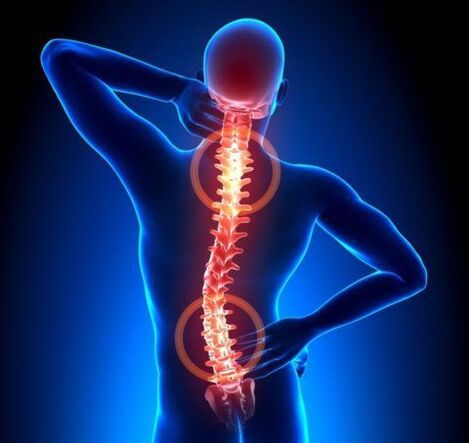
Many people aged 30-35 complain of back pain.The cause of these pains can be spinal cord disease.Osteochondrosis is a disease that occurs in middle -aged people, but most often it is detected in patients after 40 years.
Osteochondrosis - what is this disease, and what is its risk?
This term implies a dystrophic process of the subject cartilage and bone tissue.In modern medical practice, osteochondrosis is called a degenerative-decidual disease of the spine and intervertebral discs that play the role of shock absorber.The risk of the disease is that the affected disk is almost impossible to restore, and without proper treatment, disability is possible.
Osteochondrosis is a common disease?Statistics are not happy.About 85% of the world's population suffers from this disease.
This disease is the most common form among all diseases that affect the back.And according to the predominance, it is immediately after diseases of the cardiovascular system.
The essence of the disease
So osteochondrosis - what is it?It is a chronic disease that affects the joints, most often in the back.
The spinal column consists of 24 beads.Between the two beads is a disk whose purpose is to soften and devalue loads.
In normal condition, the disk is quite resilient and can resist considerable loads.In the center of the disk there is a pulp core with a lot of water.For some reason, the essence loses its hydrophilic properties.
As a result, the disk delays, decreases in height and deformation.In later stages, bone tissue growth occurs with growth formation - osteophytes that compress peripheral nerves and spinal cord.This is what is osteochondrosis of the spine.
The causes of pathology
Despite the fact that osteochondrosis is a very common disease, the reasons why the pathology develops is not fully established.

The main factors are considered:
- excess load on the back;
- injuries;
- Professional damage - weight lifting or prolonged work in an unpleasant, without movement position;
- excess body weight;
- inheritance;
- violation of behavior.
Osteochondrosis develops at one scale or another in all people of the elderly and is one of the aging processes of the body.
Stages, forms and symptoms of disease development
Experts distinguish the 4 stages of the disease:
- First stage- movement of the disk core on the edge;
- Stage 2- the appearance of cracks on the cartilage wheels and the instability of the vertebral section;
- Stage 3- a complete disk rupture with the loss of the nucleus in the spine stem, while the roots of the spinal cord are possible;
- Stage 4- Fierce changes not only on the intervertebral disc but also on the surrounding fabrics.
The main symptom of the disease is pain.It can be high intensity or dumb, moderate manifestation.
In addition to the pain, there are:
- painful back muscle tension;
- numbness of the skin in the arms and legs;
- restriction of volume of movements;
- weakness in the limb muscles;
- thinning of the arms and legs;
- Unexpected dizziness.
These are general manifestations for all forms of pathology.Depending on the spine in which the changes are distinguished, three forms of the disease are distinguished with characteristic symptoms.
Table no.1. Forms of osteochondrosis and their inherent symptoms:
| The form of the disease | Symptoms |
| Osteochondrosis in the neck | Changes in this department lead to the push of blood vessels and impaired microcirulation.For this reason, a person has constant dizziness.Sometimes this leads to pallor.There is noise in the ears and stains of color stains in front of the eyes. |
| Osteochondrosis in the thoracic beads | With this form of the disease, acute chest pain is observed.The disease can cause the progression of international neuralgia and worsen the flow of heart pathologies. |
| Osteochondrosis in the lumbar region | The pathology in the lower back is manifested by pain in the gluteal region, a decrease in the tone of IKR.A complication can be radiculus, which is associated with the spread of pain throughout the leg. |
Due to the pathology of vertebral discs, a large number of disorders in the body occurs: nerve pinching, swelling, disorder of blood circulation and fibrosis of the surrounding tissue.These changes cause a variety of symptoms, which complicate the diagnosis and prescribe proper treatment without carefully examination.
Clinical manifestations
Symptoms of the disease depend on the place where the lesion is mainly located.In the sections below, we consider the characteristic signs of each variety of the disease.
Cervical department
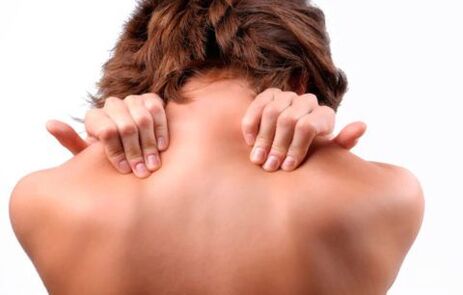
The main symptoms of cervical spine damage include:
- discomfort, neck and shoulder pain;
- muscle hypotonus;
- increased sweating;
- numbness of the fingers;
- violation of coordination of movements;
- headaches, dizziness;
- Hearing and vision problems;
- Hypertension.
With the progression of the disease and the damage to the arteries and nearby nerves, one of the following syndromes can develop:
- vertebral artery;
- cardiac;
- hypertension;
- root;
- Cervical migraine.
Violation of blood circulation in the vertebral arteries and this hypoxia of brain tissue are the dangerous consequences of osteochondrosis.
This syndrome manifests:
- Periodic system/dizziness;
- weakening of vision;
- partial or complete loss of hearing;
- Sometimes - pallor.
Important!Neurological manifestations of spinal osteochondrosis often have to distinguish with brain atherosclerosis, depots and other pathologies.
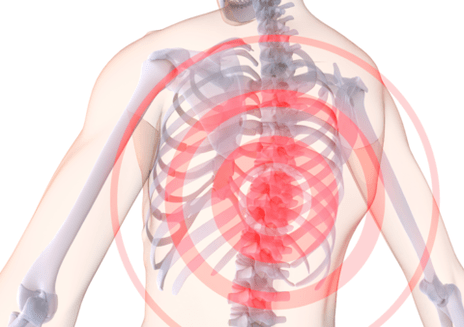
Chest region
Compared to other forms of the disease, thoracic osteochondrosis manifests less pronounced.
Among his symptoms:
- chest pain, growing at night or extension in one position;
- discomfort, a feeling of squeezing between shoulder edges;
- Strengthening pain during deep breathing.
If the disease is not treated, it will progress, causing damage to the nearby and the nerves located nearby.
Signs of the development of osteochondrosis complications of the spine of this localization may be:
- numbness of the skin in some areas, a feeling of "goose" crawling;
- Itching of the skin, burning;
- Cooling of the limbs;
- nail fragility;
- pronounced dry skin;
- pain along the esophagus and pharynx;
- Disordishes of gastrointestinal tract.
Moreover, the localization of the chest of the disease is characterized by two specific symptoms - dorsago and dorsalgia.
Dorsago is a sudden, sharp and very strong pain in the chest, a "chest switch".It can happen with prolonged in the same position, monotonous work.
Pay attention!During the breast, the pain is so severe that patients are afraid to get an extra suction.
Dorsalgia is less intense, but painful monotonous sensations that can last up to 2-3 weeks.They intensify with deep breathing, trend.
Lumbar
Osteochondrosis of the lower part of the spine, namely Lumbari, occupies a steering position for the dominance.
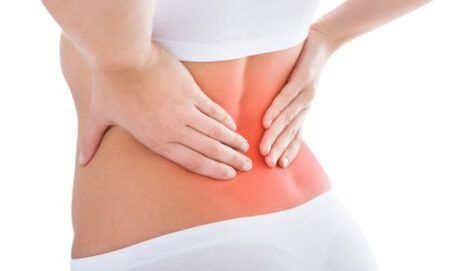
Among its characteristic symptoms:
- dull, most often pain in the back, radiating in the legs;
- discomfort, intensifying when changing your body position, sneezing, coughing, trying to lift weights;
- constant muscle spasm in the lower back;
- Lights at the bottom of the back;
- Damaged sensitivity to the skin of buttocks, buttocks, legs, legs;
- a feeling of dragged goosebumps at the lower extremities;
- Dry, peel from the skin.
Sacral Department
The sacral back osteochondrosis is extremely rare in an isolated manner and is usually a "continuation" of low lumbar damage.
This explains the features of his symptoms:
- back pain as well as signature nerve;
- Sharp "shelters" across the whole leg;
- an unpleasant feeling of disturbance in the back of the thigh;
- numbness of the lower extremities;
- Paresis, as well as unstable symptoms of impaired motor activity.
Important!Lower spine osteochondrosis can lead to such extremely dangerous complications as damaged blood supply to the spinal cord and compression myelopathy.
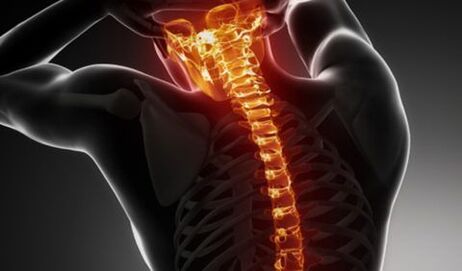
Ordinary osteochondrosis
A common form, or osteochondrosis of all parts of the spine, is the most severe version of the pathology.Due to the infinity of loss, her picture can be extremely diverse and include almost all the symptoms described above.
Diagnostic methods
The appearance of each complaint indicated above requires an appeal for a medical institution: the patient should examine the patient.The diagnosis of osteochondrosis should be complex and very complete.
Standard instruction includes the following stages:
- Collection of complaints and anamnesis.
- Clinical inspection.
- Exam X -Ray.
- Modern methods (CT, MRI).
By having a conversation with the patient, the doctor should find out:
- which concerns the patient;
- What is the place of the most pronounced unpleasant sensations;
- What is their intensity and duration;
- provoking their strengthening;
- which helps to cope with the pain.
Important!Be sure to tell your doctor how long you worry about such complaints and if you received any treatment earlier.
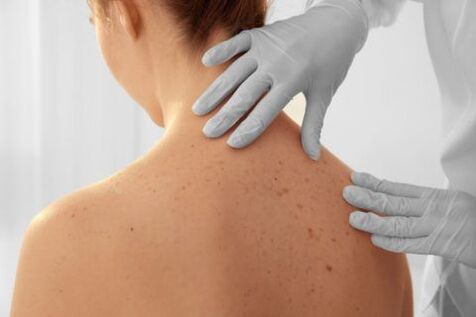
During a clinical inspection, the specialist estimates:
- the position of the patient's body, his walking, the volume of active and passive movements;
- presence of skin defects, redness, peel;
- symmetry of healthy and sick parts of the body;
- presence of muscle spasm;
- pain area of pain;
- The presence of pain, fever and other types of sensitivity.
During radiography, each spine for better visualization is studied individually.The pictures are taken in direct, side and (according to indications) of the two oblique projections.To evaluate the phase and severity of degenerative-district changes, X-ray classification of osteochondrosis of the spine of the zeaker is used.
Table: Stages X -Ray of osteochondrosis of the spine:
| Scene | Description |
| I (+) | Unprecedated changes in lordosis in a small number of segments |
| II (++) |
|
| III (+++) | Expressed changes, significant narrowing of intervertebral holes |
| IV (++++) | Significant narrowing of intervertebral holes, mass existent, often irreversible changes |
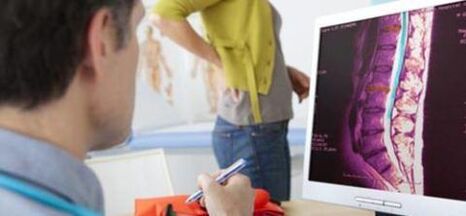
With insufficient content of the Rain Painting Information, the patient may describe more modern-ct tests (intended images of one or more segments of the spinal column) and MRI (diagnostic visual methods based on electromagnetic radiation properties).
Treatment
First of all, the doctor explains to the patient what osteochondrosis is and how to treat it.He talks about a series of measures to be taken for a long period.
Disease therapy is performed taking into account the phase.In the initial period of illness, massage, physiotherapy, physiotherapy exercises are indicated.But as the dystrophic process progresses, various orthopedic devices should be used to immobilize the spine.Drug treatment is also needed.
Surgical intervention is shown with complications and the ineffectiveness of conservative treatment.
medicaments
The most important tasks of treatment with pharmacological drugs are pain relief, elimination of nerve root inflammation, restoring cartilage structure, improvement of blood circulation and food, stopping the development of pathology.There are several groups of medicines that can be prescribed in this case.
At the pharmacy, they are represented in various forms and in a wide variety.Medication pricing can be different and you can always choose the most affordable.
Table no.2. Medicines used in conservative osteochondrosis therapy:
| Pharmacological | Therapeutic effect | Instructions for use |
| Chondroprotectors | Slow down the degeneration processes of the cartilage, contributes to its restoration. | Get 1 capsule for a month.If necessary, the course of treatment is repeated. |
| NSAID | It has an anesthetic effect, reduces the inflammatory process. | Get a pain tablet.With severe pain, intramuscular injections of the drug are used. |
| B vitamins | Improves nerve impulse conductivity, restores microcirculation to the affected cartilage area. | The course of treatment with intramuscular injections is performed. |
| Musorexant | Relax the muscles, relieves tension, relieves pain. | Take a tablet 2 times a day. |
The drug is prescribed according to the doctor's testimony.Self -medication can be ineffective, and in some cases damage.
Physiotherapy for osteochondrosis
What to do with osteochondrosis, in addition to medication, to accelerate healing?One of the most effective methods of treating this disease is physiotherapy.
Its advantage is a selective effect on the focus of the disease.Physiotherapy contributions to reduce pain, elimination of inflammation and enhance general immunity.With their help, muscles relax, metabolic processes and blood circulation are normalized.
For osteochondrosis, they are used successfully:
- magnetotherapy;
- Laser therapy;
- shock wave therapy;
- quartz;
- electrophoresis;
- The effect of low frequency electric currents.
Physiotherapy does not perform if the patient is in serious condition, with a deterioration of the disease, oncological diseases and mental disorders.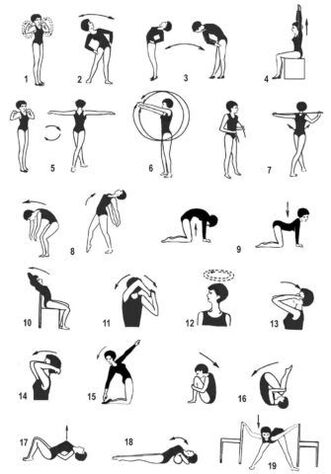 In other cases, physiotherapy has a beneficial effect on the recovery process, increases the effect of medication, which reduces their dose.
In other cases, physiotherapy has a beneficial effect on the recovery process, increases the effect of medication, which reduces their dose.
Physical education
Physical education classes are prohibited in the acute period of illness.After eliminating this period, the doctor prescribes therapeutic exercises, which he or she develops together with the instructor individually for each patient.
With the help of exercises, the muscle corset is strengthened, which prevents the spine bending and allows you to distribute the load on the beads correctly and evenly.With regular physical exercises, medicinal substances penetrate the spine at higher concentrations than in their absence.
It is necessary to be included in the instruction of an experienced instructor and carefully monitor their condition.With discomfort and severe pain, exercise should stop.
PREVENTION
Knowing what osteochondrosis and its consequences is, it will be useful to think about prevention.
Preventive measures are quite simple, they are easy to perform for all those who care about their health:
- prevention of damage;
- Regular physical training (swimming is very useful);
- maintain normal weight;
- Do not charge the spine;
- Monitor the correctness of the behavior;
- Not to be in a position for a long time;
- Avoid unexpected movements when lifting weights.
When you meet these rules, the period of forgiveness will be long.
Osteochondrosis is a very serious disease.But with the timely search of a doctor and adequate treatment, it is possible to stop its devastating effect.
Questioning
Pain
Hello, tell me please.I'm 24 years old.For the last two months, the pain in the neck, the back of the head (sometimes still gives whiskey, eyes).I also notice a strong cramp on the neck, tingling and numbness of the hands, tongue and sky.
I suspect osteochondrosis, because both the mother and grandmother from the youth are tortured with similar symptoms.Where to start the exam?And another question: Can I go to aerobics?
Make an R-Scheme store (CT) and doppler of the head and neck vessels.You have probably developed vertebral artery syndrome against the backdrop of cervical osteochondrosis.A further plan for diagnosis and treatment can only be designed after you have received the results of these tests.
It is better not to visit the aerobics yet.
Lumbar osteochondrosis
For seven years I have tried with the lower back, the deterioration of osteochondrosis is almost every 2-3 months.Injection and tablets help for a short time, and then the pain turns.I work as a postal, it gets harder.Am I set incompetence?
Hello!The decision to deliver the disability group has been made from ITU based on a comprehensive study of your situation.First you need to contact the therapist and undergo an exam.
As a rule, with lumbar osteochondrosis, a disability group is not shown.Its pride is possible with the development of complications (protrusions, intervertebral hernias, etc.).But, again, I repeat, everything is individual here.

























